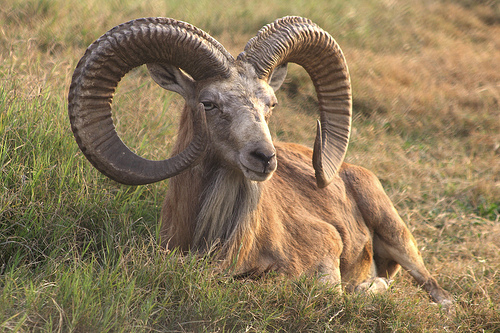
Urial(Ovis vignei)
Phylum —chordata
Class — mammalia
Order — artiodactyla
Family — bovidae
Genus – ovis
Appearance
Urial males have large horns, curling outwards from the top of the head turning in to end somewhere behind the head; females have shorter, compressed horns. The horns of the males may be up to 100 cm (39 in) long.
The shoulder height of an adult male urial is between 80 and 90 cm (31 and 35 in).
Habitat
The urial inhabits western central Asia from the northeast of Iran and the west of Kazakhstan to Balochistan in Pakistan and the Ladakh regions in North India.
Behavior
Urial are primarily diurnal, and forage for most of the day.
These sheep are gregarious, forming herds of related individuals. The make-up of a herd is usually females, lambs, and juveniles. Older rams form separate groups where the members are all male. Herds maintain a social structure where dominance is based on an animal's body size.
Aggressive interactions between individuals of similar size usually include front kicks and head twists. These sheep do not rear up on their back legs when fighting.
Diet
Urial are herbivorous and eat a range of plants, probably grasses and shrubs. They also eat grains.
Reproduction
Urial are polygynous, which means that one male mates with multiple females. The mating season is from November to December. They bear one lamb after a 5-month gestation period. Older ewes may bear 2 or 3 lambs. Females separate themselves from their herd before giving birth. After delivery, mothers and their lambs stay away from the herd for a period of 3 to 7 days. This is a time when the lamb gains in strength and the mother and her baby learn to recognize one another by smell. They then return to their herd. Lambs nurse from their mothers for 5-6 months. Ewes are sexually mature when they are 1.5 years old, and can produce their first offspring at 2 years of age.
Maximum longevityis 17 years (in captivity).
In captivity
When designing aviaries, you need to take into account the main functional schemes of animal life:
- food;
- absence of stress factors (proximity of predators, unfavorable climatic conditions);
- ability to move;
- availability of the appropriate species group;
- the prospects of reproduction of the population.
The enclosure infrastructure is set on the landscape, terrain, and availability of pastures and should include the following main elements:
- special facilities for animal feeding and veterinary activities;
- complex feed platforms;
- hay feeders;
- special stones for licking;
- reservoirs or structures for ensuring uninterrupted water supply;
- shelters from the weather.
 Russian
Russian
 English
English
























